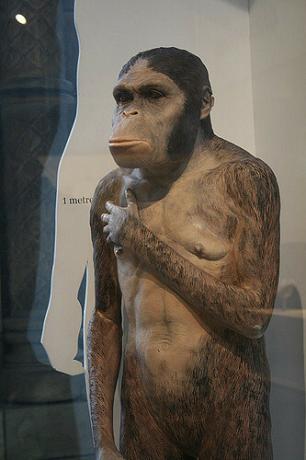Human evolution corresponds to the process of change that gave rise to human beings and differentiated them as a species.
The characteristics of the human species were built over thousands of years, with the evolution of primates. Charles Darwin was the first to propose the kinship relationship of the human species with the great apes, the anthropoids.
Scientists now believe that these anthropoids and the human species had a common ancestor about 8 to 5 million years ago. Evidence of this fact is the great similarity between humans and anthropoid apes, such as chimpanzees.
The evolution of the human species started at least 6 million years ago. During this period, a population of Northwest African primates split into two lineages that evolved independently.
The first group remained in the rainforest environment and gave rise to chimpanzees. The second group adapted to more open environments, such as the African savannas, giving rise to the homo sapiens. Therefore, the African continent is called the cradle of humanity.
The Stages of Human Evolution
The pre-australopithecines
These first species lived right after the separation from the group that gave rise to hominids and chimpanzees.
Its main feature was the arboreal way of life.
The fossil record dates back some of the species from this period:
Sahelantropus tchadensis: Fossil found on the African continent, belonging to a species of primate. This species already had the bipedal posture. It is the oldest ancestor of the human lineage.
Orrorin tugenensis: Fossil found in Kenya. Also already presented indications of the bipedal posture. Scientists believe the species lived 6 million years ago.
Ardipithecus ramidus and Ardipithecus kadabba: Fossil found in Ethiopia. In these species the bipedal posture remains. Scientists believe a species of the genus Ardipithecus it was the ancestor of the Australopithecines.
the australopithecines
The first hominids belonged to the genus Australopithecus.
They constituted a diverse and successful group.
The main characteristics of this group were: erect posture, bipedal locomotion, primitive dentition and the jaw more similar to that of the human species.

They were the first hominids to dominate fire, which allowed its expansion into other territories. In addition to reducing the muscles of the face, as they could cook food, softening it.
Australopithecus africanus: The first australopithecine fossil found. It probably inhabited the Earth 2.8 to 2.3 million years ago.
Other australopithecine fossils have been found. Some species are: THE. afarensis, THE. robustus and THE. boisei.
Many australopithecines are believed to have coexisted and competed with each other. All species have gone extinct.
However, one of them would have been the ancestor of the genus Homo.
The gender Homo
The extinction of most australopithecines made possible the emergence of a new lineage.
The gender Homo stands out for the development of the nervous system and intelligence. In addition, it had evolutionary adaptations, such as bipedalism.
homo habilis: Currently, with the study of fossils, the most accepted is to consider it as australopithecine, being Australopithecus habilis. The species lived around 2 million years to 1.4 million years ago.
homo erectus: This species stood out for the manufacture of instruments and utensils made of stone, wood, skin and bones. The group left Africa and reached Europe, Asia and Oceania.
homo ergaster: It would be a subspecies of H. erectus who would have migrated to Europe and part of Asia, where he gave rise to several lineages, one of them the Homo neanderthalensis.
Homo neanderthalensis: Known as Neanderthals, they had a cold-adapted body, no chin, a low forehead, bowed legs, and a larger brain than human beings today.
Neanderthals had rudimentary verbal communication, social organization and burial of the dead.
This group coexisted with the first modern men. Currently, it is believed that modern man emerged in Africa between 200,000 and 150,000 years ago, from the lineages of H. ergaster.
Learn more about man in prehistory.
the modern man
O homo sapiens sapiens is the scientific name of modern man, being a subspecies of homo sapiens.
The main characteristic of modern man, compared to his ancestors, is a well-developed brain. In addition, the capacity for reasoning, communication and intelligence is observed through the development of the nervous system.

Check out the classification of the human species:
| Kingdom | animalia |
|---|---|
| Phylum | Chordata |
| subphylum | vertebrate |
| Class | Mammalia |
| Order | Ape |
| Suborder | Anthropoid |
| Family | Hominid |
| Gender | Homo |
| Species | homo sapiens |
| Subspecies | homo sapiens sapiens |
Know more about:
- Evolution
- Evolutionism
- Evolution theory
- Exercises on evolution


